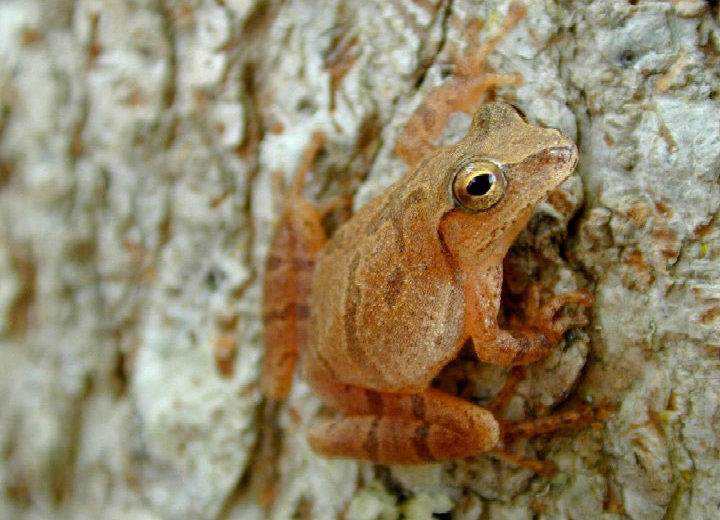Listen for Frogs Calling in Spring

Written by Heather Fitzgerald
The best part of spring, in my opinion, is hearing the calling of frogs and toads. The dramatic changes that spring ephemeral wildflowers, trees, and other plants go through as they flower and leaf out are just so…quiet. Frogs and toads, most of whom are emerging from a long, cold winter buried under leaf litter and logs on the forest floor and making their way to a nearby body of water, call out for our attention as the males call loudly for mates. The folks at the Vermont Reptile & Amphibian Atlas (a good cause) have found seven frog and toad species in Burlington: wood frogs, spring peepers, northern leopard frogs, American toads, gray treefrogs, green frogs, and bullfrogs. Their presence in the survey makes them good bets to look for around town, but the survey was not exhaustive, so the locations given by no means suggest that these are the only places they might be. You could find them anywhere, perhaps in your backyard or community garden plot. How many different kinds of frogs and toads and seen or heard? The Atlas welcomes your findings. My favorite online recordings of frog calls are on one simple page by naturalist and author Lang Elliot.
Wood frogs are often the first frogs people hear calling, peaking in mid-April. They are my favorites. I hear a chuckling sound; guidebooks often describe it as a duck-like quacking. They are brown or reddish with darker “backpack straps” along the side of each shoulder. They are usually found in vernal pools (small bodies of water that fill with snowmelt in spring and dry out sometime in summer—thus not containing any fish that might eat the vulnerable tadpoles). Females lay eggs in a softball-sized mass. They have been found in Burlington in the Arms Grant and at Rock Point, Centennial Woods, Ethan Allen Homestead, Ethan Allen Park, and Delta Park.
Spring peepers give loud, piercing peeps. People describe them as sounding like jingling sleigh bells from a distance. They can start as early as March and continue through July, peaking in early May. They are a little smaller than our other frogs (1-1 ½ inches), brown, and often have a dark “X” mark on their backs. They attach eggs singly or in packages of 2-3 to vegetation. They are not too fussy about the bodies of water they lay their eggs in—even a ditch can suffice. In Burlington they have been found along the bike path including the pond near North Beach and at Rock Point, in Centennial Woods, and in the Intervale including Ethan Allen Homestead.
The northern leopard frog call is a long (3 second) snore that starts softly and gets louder, followed by some soft grunts. The snore reminds me of the sound you can make by running your thumb along the tines of a comb, and the Atlas describes the grunts as sounding like rubbing a balloon. They are gold or green with black spots and a white belly. They need a permanent water body to overwinter in, floodplains or wetlands to breed in, and wet fields to forage in. They call from April-mid-May, reaching their peak in mid-April. Eggs are tightly packed into a softball-sized mass. They have been found in Burlington at Derway Island, Ethan Allen Homestead, and along the Winooski River. They are slightly less common than the other species of frogs found in Burlington.
The American toad‘s call is a high-pitched, long (up to 30 second) trill. It calls from April-July, peaking in early May. They have dry, warty skin, lay their eggs in long strings, and are the most common amphibian in Vermont. They have been found in Burlington in the retaining pond behind Centennial Field and near the Sheraton, and also off of the south end of Pine St.
The gray treefrog repeats its short trill every few seconds. They often call from trees (where they feed) on warm, humid nights from April-July, peaking in early June, and breed in slow or still water bodies that are heavily vegetated. They range in color from green to gray, depending on age, and adults have a lichen-like pattern on their backs. They have been found in Burlington in Centennial Woods, along the bike path including near ECHO, North Beach, Rock Point, and near the Miller Recreation Center on Gosse Ct.
The green frog call sounds like a plucked banjo string (“GUNK gunk gunk”). It can be heard from April-July, peaking at the start of July. Their appearance is quite variable, ranging from mottled green to brown with stripes, often broken, on their legs. Females lay eggs in a film on top of the water in permanent bodies of still water that have emergent vegetation. They have been found in Burlington in Centennial Woods, near the Sheraton, in the Intervale including at Ethan Allen Homestead, and along Lake Champlain between North Beach and Rock Point.
In my family we call the American bullfrog the NASCAR frog, because its call sounds like cars racing around a track (I hear a deep “rum, rum,” though many guidebooks describe it as “jug-o-rum”). They call from May-August, peaking in early July. They are our largest frog; their bodies (not including legs!) can be up to 7 inches long. They range from mottled green to brown, have stripey legs, and are found in or near large bodies of water with a marshy shoreline nearby. The eggs form a film on top of the water. In Burlington they have been found in the Intervale and at Lake Champlain between North Beach and Rock Point.
This spring, as you hear the frogs start calling, take some time to figure out who they are, with either your ears or your eyes. If you haven’t met these neighbors yet, I think you’ll be thrilled to make their acquaintance. Maybe you will become a frog call collector, too!
Photo: USGS
